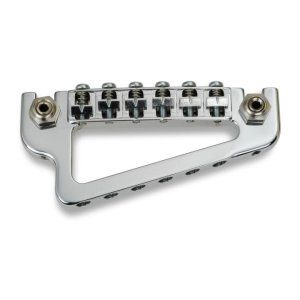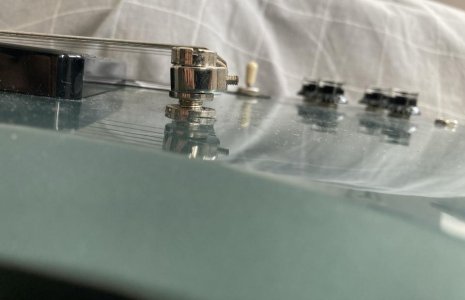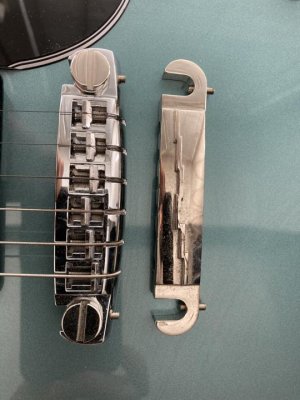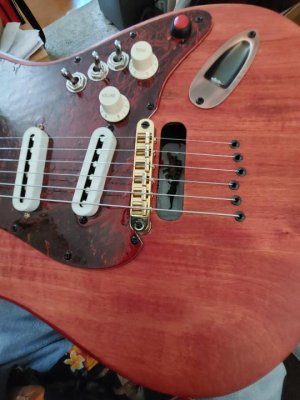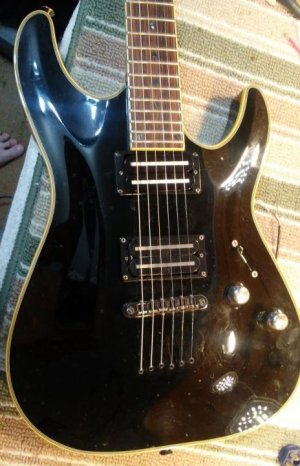You are using an out of date browser. It may not display this or other websites correctly.
You should upgrade or use an alternative browser.
You should upgrade or use an alternative browser.
TOM bridge question.
- Thread starter Artie
- Start date
beaubrummels
Well-known member
No. Fig. 2 is a Tune-O-Matic. Fig. 1 is just a compensated wraparound bridge.
beaubrummels
Well-known member
I think you might know all or at least some of this, but for the benefit of others that might be reading...
As far as which is 'better', technically the TOM can be properly intonated and handles adjusting the length of the string for different string gauge changes, etc. While the compensated bridge works well, obviously it doesn't allow adjustment when you try different specific string gauge sets; it's more of an average.
All that said, IME, I have bridges that are just straight bars on some guitars and those guitars actually play in tune about as well as compensated bridge guitars. There's only a few specific spots on the neck where notes are out.
Where I've noticed a fully-adjustable TOM is 'better' is when the guitar has other problems, like improper relief, a slight twist in the neck, or other issues. I'm able to get a guitar to play reasonably well in tune despite neck issues with a fully-adjustable bridge. Compensated or bar bridges really require the neck to be perfectly set up.
Also, it's worth noting there are two main types of TOM bridges that came from Gibson, ABR-1 and Nashville (the later wider Harmonica type in the '70s came from Schaller). ABR-1 is the original type that was narrower, often had a wire to hold the bridge saddles in, and it screwed directly into the wood of the guitar. Nashvilles are wider, so they have more adjustment travel, but they thread into inserts in the wood, rather than directly. ABR-1s tended to flatten or collapse under string tension after 20+ years or more because they were smaller, narrower and had less metal mass. ABR-1s also didn't have enough travel on the saddles to properly intonate, so people often have to flip the lower E and A saddles around backwards to get the saddle back far enough. But ABR-1s supposedly sound better because they screw right into the wood. Nashvilles intonate better because they have more width to travel to set the string length, but because they are wider like that, on solid body electrics that use a stop bar tailpiece, typically the strings break over the back of the bridge instead of straight from the saddle to the tailpiece. This either forces you to raise the tailpiece stop bar, or top-wrap the tailpiece stop bar to get the string straight into the bridge saddle.
Between the ABR and the Nashville, which is 'better'? Personally I prefer the ABR with the original aluminum type tailpiece stop bar, as long as the bridge height adjustment screws are drilled at sufficient offset angle that I don't have to flip saddles and run out of travel to set the string length. IME having the bridge sink directly into the wood and having the strings anchored into an aluminum stop bar tailpiece seems to affect the tone and sustain in ways that make it sound like a famous record. But that's not a guarantee. It really depends on the guitar. A guitar with certain woods and construction with a brass or steel stop bar and other specific hardware changes like beefy Grover tuners and certain pickups and setup can certainly get near-equivalent in tone and sustain.
As far as which is 'better', technically the TOM can be properly intonated and handles adjusting the length of the string for different string gauge changes, etc. While the compensated bridge works well, obviously it doesn't allow adjustment when you try different specific string gauge sets; it's more of an average.
All that said, IME, I have bridges that are just straight bars on some guitars and those guitars actually play in tune about as well as compensated bridge guitars. There's only a few specific spots on the neck where notes are out.
Where I've noticed a fully-adjustable TOM is 'better' is when the guitar has other problems, like improper relief, a slight twist in the neck, or other issues. I'm able to get a guitar to play reasonably well in tune despite neck issues with a fully-adjustable bridge. Compensated or bar bridges really require the neck to be perfectly set up.
Also, it's worth noting there are two main types of TOM bridges that came from Gibson, ABR-1 and Nashville (the later wider Harmonica type in the '70s came from Schaller). ABR-1 is the original type that was narrower, often had a wire to hold the bridge saddles in, and it screwed directly into the wood of the guitar. Nashvilles are wider, so they have more adjustment travel, but they thread into inserts in the wood, rather than directly. ABR-1s tended to flatten or collapse under string tension after 20+ years or more because they were smaller, narrower and had less metal mass. ABR-1s also didn't have enough travel on the saddles to properly intonate, so people often have to flip the lower E and A saddles around backwards to get the saddle back far enough. But ABR-1s supposedly sound better because they screw right into the wood. Nashvilles intonate better because they have more width to travel to set the string length, but because they are wider like that, on solid body electrics that use a stop bar tailpiece, typically the strings break over the back of the bridge instead of straight from the saddle to the tailpiece. This either forces you to raise the tailpiece stop bar, or top-wrap the tailpiece stop bar to get the string straight into the bridge saddle.
Between the ABR and the Nashville, which is 'better'? Personally I prefer the ABR with the original aluminum type tailpiece stop bar, as long as the bridge height adjustment screws are drilled at sufficient offset angle that I don't have to flip saddles and run out of travel to set the string length. IME having the bridge sink directly into the wood and having the strings anchored into an aluminum stop bar tailpiece seems to affect the tone and sustain in ways that make it sound like a famous record. But that's not a guarantee. It really depends on the guitar. A guitar with certain woods and construction with a brass or steel stop bar and other specific hardware changes like beefy Grover tuners and certain pickups and setup can certainly get near-equivalent in tone and sustain.
Artie
Peaveyologist
Great write-up beau. I've copied and pasted that into my "reference" folder.
I've loved those since I've first seen them. Maybe one will find it's way unto an axe someday. In the mean time, I have, or have had, the regular Hipshot bridge on a couple guitars, including my Fender P-Bass. (Had, the bass, I should say. Sold it to focus on guitar.)
P.S. I have a couple guitars that cost less than that bridge.
There's also the Hipshot Baby Grand, I don't have a guitar that would take it but I like the idea a lot.
I've loved those since I've first seen them. Maybe one will find it's way unto an axe someday. In the mean time, I have, or have had, the regular Hipshot bridge on a couple guitars, including my Fender P-Bass. (Had, the bass, I should say. Sold it to focus on guitar.)
P.S. I have a couple guitars that cost less than that bridge.
Last edited:
Ashurbanipal
Well-known member
^^ What B said.
I've certainly seen some builders who use ABRs rigging them up prior to drilling for the studs so they can determine the best spot for intonation so the saddles end up roughly in the middle with decent travel either way. Gibson themselves experimented with this in the past; I was looking at very early SGs at one point (the 1960 variants, with the inked serials etc.) and many of those don't have a canted bridge (or barely). Conversely, when the SG Special and Junior were introduced in 1961, they had the quite steeply canted plain wraparound.
With wrap bridges, it depends on the player to an extent. For some, the uncompensated or the lightning bar versions are close enough for rock'n'roll; if you play chordal stuff past the 12th fret, maybe you might balk at intervals not being in tune. There are also those Music City and Mojoaxe ones now which have compensation, but with the non-lightning bar look, both for a canted or straight setup.
Not all lightning bar versions are necessarily equal either - Epiphones use one where the treble string compensation is raked forward more than on Gibsons. On my Epi SG this meant the guitar couldn't be intonated well, at least, not with out significantly canting the treble side (don't know if the set screw was long enough). My main peeve is the fact that they're made so the slots in the studs are wider than the tailpiece ears, so the whole thing tips forward under tension; with lighter strings especially, the high E can exhibit sitaring and/or scrape along the top when bending. Of course, these bridges were designed when the typical gauge was 11 or 12 (with wound G) and people weren't bending so it mattered less! Still, it was a design flaw people contended with in the past too, and sought to solve it by snipping washers in half and jamming them between the stud and ear so the bridge would sit parallel with the body. Now we have the elegance of locking studs.
For my SG I got the Stew Mac Golden Age wraparound, which is very nice. Identical to Faber Wraptonate. Plenty of range for intonation and feels very nice on the palm.

The Vox SDC guitars had a proprietary take on the same concept as the Hipshot Baby Grand.

I've certainly seen some builders who use ABRs rigging them up prior to drilling for the studs so they can determine the best spot for intonation so the saddles end up roughly in the middle with decent travel either way. Gibson themselves experimented with this in the past; I was looking at very early SGs at one point (the 1960 variants, with the inked serials etc.) and many of those don't have a canted bridge (or barely). Conversely, when the SG Special and Junior were introduced in 1961, they had the quite steeply canted plain wraparound.
With wrap bridges, it depends on the player to an extent. For some, the uncompensated or the lightning bar versions are close enough for rock'n'roll; if you play chordal stuff past the 12th fret, maybe you might balk at intervals not being in tune. There are also those Music City and Mojoaxe ones now which have compensation, but with the non-lightning bar look, both for a canted or straight setup.
Not all lightning bar versions are necessarily equal either - Epiphones use one where the treble string compensation is raked forward more than on Gibsons. On my Epi SG this meant the guitar couldn't be intonated well, at least, not with out significantly canting the treble side (don't know if the set screw was long enough). My main peeve is the fact that they're made so the slots in the studs are wider than the tailpiece ears, so the whole thing tips forward under tension; with lighter strings especially, the high E can exhibit sitaring and/or scrape along the top when bending. Of course, these bridges were designed when the typical gauge was 11 or 12 (with wound G) and people weren't bending so it mattered less! Still, it was a design flaw people contended with in the past too, and sought to solve it by snipping washers in half and jamming them between the stud and ear so the bridge would sit parallel with the body. Now we have the elegance of locking studs.
For my SG I got the Stew Mac Golden Age wraparound, which is very nice. Identical to Faber Wraptonate. Plenty of range for intonation and feels very nice on the palm.

The Vox SDC guitars had a proprietary take on the same concept as the Hipshot Baby Grand.

Artie
Peaveyologist
I have a similar problem with my B.C. Rich (Bronze Series) Warlock. Steep neck angle, combined with soft wood, (Agathis), results in a lean that exposes bare wood, and a teensy bit of the mounting hole. I have to believe they knew this when they designed it, because they include super long set-back screws, so you could intonate it properly. I imagine that once this has settled, (years ago), it won't move any more. I've had this for at least a decade, and the intonation seems stable.
BTW . . . this is a guitar I got from a forum bro, that was less than that Hipshot bridge. So no complaints.
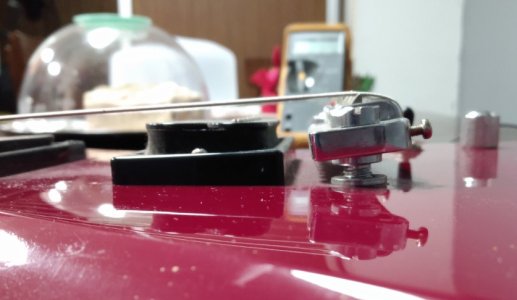
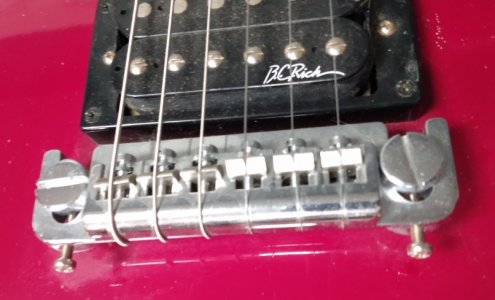

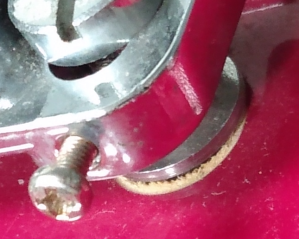
BTW . . . this is a guitar I got from a forum bro, that was less than that Hipshot bridge. So no complaints.




Ashurbanipal
Well-known member
^^ Yeah, a familiar sight. The mahoganyish wood Epiphone uses is not particularly hard, probably wht my SG also had slightly leaning bushings (more pronounced on the bass side) out of the gate. I got some locking studs to stop the process developing further. Not sure what the neck angle is, certainly steeper than the Custom Shop guitars, which, like the originals, are on the shallow side so there's hardly - if any - possibility to go down.
The Stew Mac bridge came a bit later as the cherry on the cake; they were blowing out unslotted ones for $30 last year at one point, that's why I got it . Correct intonation pattern with new vs. preset compensation of stock.
. Correct intonation pattern with new vs. preset compensation of stock.
The Stew Mac bridge came a bit later as the cherry on the cake; they were blowing out unslotted ones for $30 last year at one point, that's why I got it
Attachments
Artie
Peaveyologist
^^^ Yours is/was about as bad as mine. One of the reasons I got this guitar was to play (mod) with it, so I still may do something with that bridge. Maybe convert it to a true TOM. Maybe something else. But I've noticed the value of these Bronze Warlocks, (that still have good, or unbroken, horn tips), are slowly gaining value. So, maybe leave it alone. :dunno:
Ashurbanipal
Well-known member
A set of metric locking studs and fixing the bushings if they're loose may suffice. Some guitars develop the problem sooner than later, or not at all. But having well coupled parts is a better guarantor of it not happening at all, and you may notice an improvement in overall resonance.
Artie
Peaveyologist
I was thinking of doing something radical, like routing out the neck pocket to remove the neck angle. Then using a flat "hipshot-style" or Strat-style bridge. If it doesn't work out, I could just put one of those Stew-Mac shims in there to bring the angle back. Or a little less angle.
Last edited:
Ashurbanipal
Well-known member
Yeah, that would be cool too. Or even something like those old Hamer Sustain Block bridges, that would be a fun one  ; John Mann makes a version nowadays (not cheap though).
; John Mann makes a version nowadays (not cheap though).
With locking studs, the TonePros ones are another option. They offer a version with the less pronounced stud heads, like PRS style, though the diameter is about 2mm greater than Gibson type.
With locking studs, the TonePros ones are another option. They offer a version with the less pronounced stud heads, like PRS style, though the diameter is about 2mm greater than Gibson type.
Artie
Peaveyologist
I had to look that up to see what it is. I'm not sure I "get" what it's all about, unless it's just that it has a heavy base. I do still have a Hipshot bridge laying around here somewhere, still in its original package. The "Allparts" price sticker is still on it. I got it back when it sold for $45. :banana:
Ashurbanipal
Well-known member
Yeah, it's the chunky base and brass saddles; first introduced on the Sunburst model in the 70s.
Love finding (semi)forgotten 'nos' things in the parts bin .
.
Love finding (semi)forgotten 'nos' things in the parts bin
Artie
Peaveyologist
Chistopher
malapterurus electricus tonewood instigator
One thing worth noting about the adjustable wraparounds is that they usually can't be lowered as far as a either a compensated wrap around (because the saddles are taller) or a regular TOM (because they are mounted the same was as a stopbar)
I'm sure someone makes one that doesn’t have that issue, but it's worth noting that it can be a problem.
I'm sure someone makes one that doesn’t have that issue, but it's worth noting that it can be a problem.
Similar threads
- Replies
- 8
- Views
- 331


